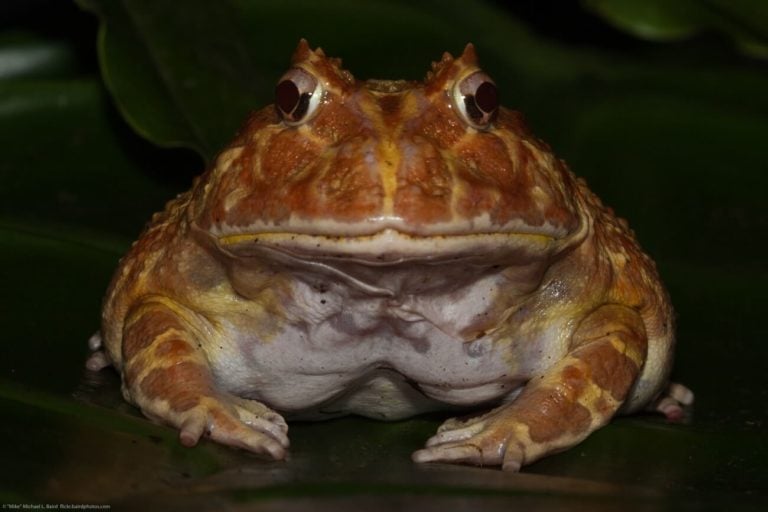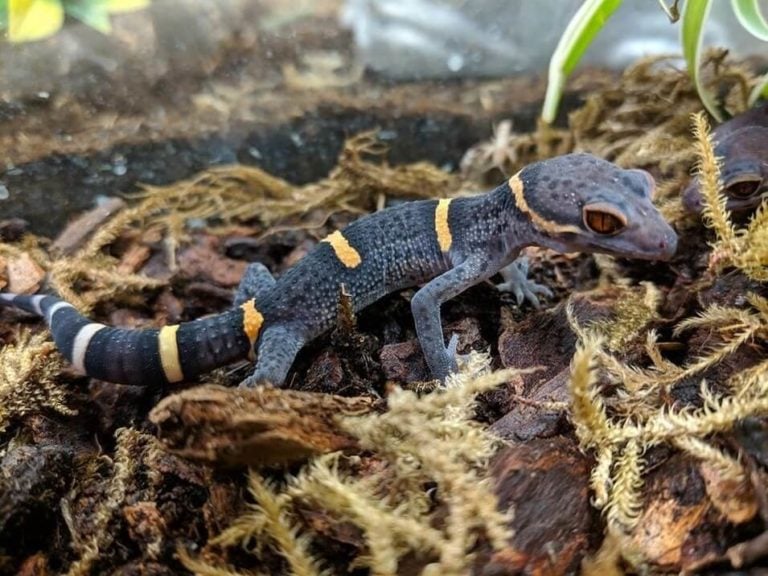Gargoyle geckos are unique reptiles and quite popular pet options. This is mainly because they’re easy to care for and look quite interesting as well!
But despite their popularity, plenty of owners provide subpar care due to incorrect information. We see this happen all the time.
In an effort to prevent this, we created this guide that covers everything you should know when it comes to gargoyle gecko care. You’ll learn about their habitat setup, diet, lifespan, size, and more.
Table of Contents
Species Summary
Known for its beautiful coloration and easy-going nature, the gargoyle gecko (Rhacodactylus auriculatus) is one of the more sought-after gecko species in the reptile trade. A polymorphic species by nature, these geckos can take on a myriad of colors and patterns.
As a result, they’re a favorite among owners who heavily value aesthetics!
The gargoyle gecko has a limited natural distribution. They’re typically only found in the southern parts of New Caledonia, which is a small island nation east of the Coral Sea and Australia.
The natural habitat of these geckos is under threat of deforestation, which could lead to future export restrictions. Luckily, gargoyle geckos are frequently bred in captivity.
Wherever they come from, the gargoyle gecko is a hardy species that’s easy to care for and a joy to raise!
Appearance & Colors
This lizard has a few defining traits. They’re identifiable by the triangular-shaped head and semi-prehensile tail. Of course, they also have the signature round toe pads that you come to expect from all types of geckos.
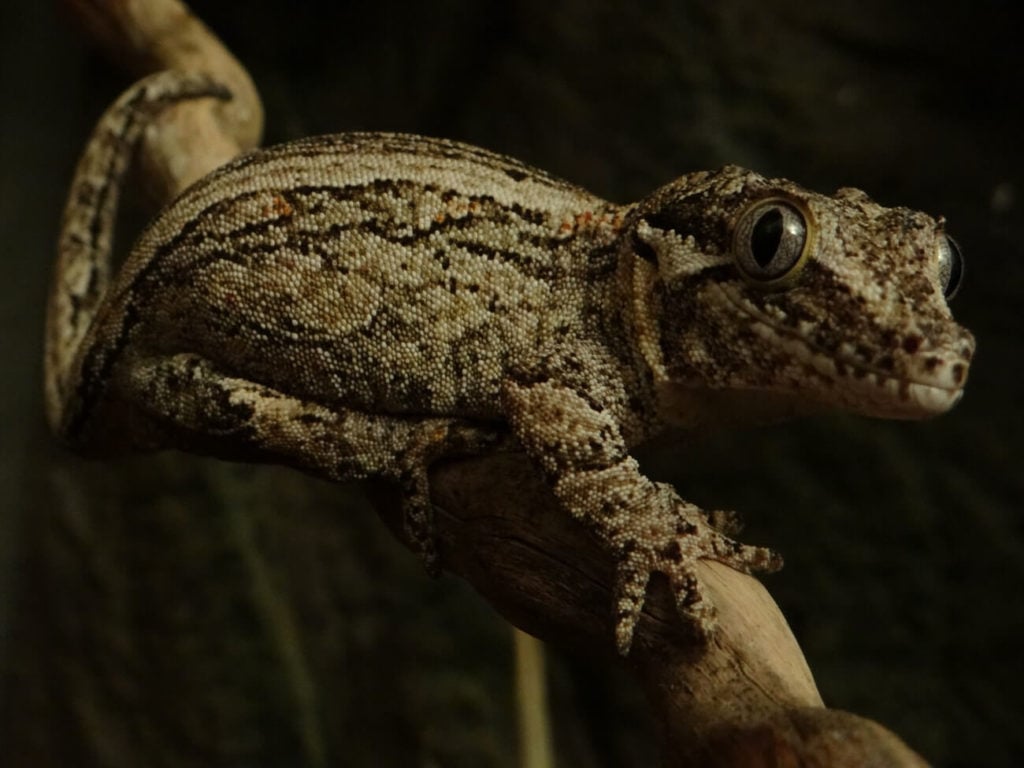
The most defining trait of the gargoyle gecko is the bumps on its head. These cranial bumps resemble horns or ears, which is how they get their common trade name.
The gecko also has large bulging eyes. For most specimens, the eyes are stone-colored and feature thin slit pupils.
As a polymorphic species, there aren’t any “standard” colorations. Several colors and patterns occur naturally in the wild. In captivity, the lizards are often selectively bred to take on the most vivid!
For color, you might see shades of brown, gray, white, yellow, orange, and red. Generally, the more muted colors will act as the base while the more vivid hues appear as accents.
Patterns vary just as much as color. There are striped geckos, mottled geckos, and reticulated gargoyles. You may also see some with random blotches of color throughout the body.
Expert Tip: Sexing gargoyle geckos is difficult. As juveniles, the differences are nearly impossible to spot. When they get older, you can sex them by examining the base of the tail.
Both males and females have bulges, but the bulge is bigger on males. Additionally, males have femoral pores between the hind legs.
Gargoyle Gecko Lifespan
The typical gargoyle gecko lifespan is somewhere between 15 and 20 years. The long life expectancy of this reptile is one of the many reasons for their popularity.
However, reaching their maximum lifespan is only possible with proper care. Like any other pet reptile, this species depends on high-quality husbandry to stay healthy. Without a well-maintained living environment and an adequate diet, these pet lizards can suffer from disease and poor health.
Average Size
The average gargoyle gecko size is seven to nine inches in length (including the tail). That makes this species a small to medium-sized lizard.
While there have been situations when this reptile has grown to be larger, it’s quite uncommon. Even with great care and genetics, they’ll likely fall within the normal size range.
Gargoyle Gecko Care
Gargoyle gecko care is relatively easy, since these are hardy reptiles. They adapt well to life in captivity and can live long and healthy lives with the right care.
As always, there are some important care guidelines to follow if you want them to be as healthy as possible. The following sections contain the most useful information you need to cover their bases and provide your gecko with the best life possible.
Enclosure Size
You don’t need a huge enclosure for the gargoyle gecko. In fact, it’s possible to keep a single gecko in a 10-gallon tank without any problems.
We recommend keeping a single gecko in a reptile vivarium that’s 12 inches long, 12 inches wide, and 12 inches tall. To better replicate their natural environment, go with a tank that’s a bit taller if possible.
Gargoyle geckos are arboreal, so they need ample height to climb. Go with an enclosure that is glass or plastic for humidity retention. Vents and a front-facing door is good, too.
If you want to keep a bonded pair, you can choose an enclosure that’s approximately 18 inches long, 18 inches wide, and 24 inches tall.
Expert Tip: Larger tanks can work for both single or paired geckos. However, it will be more challenging to regulate temperature and humidity.
Habitat Setup
The best thing you can do for your gargoyle gecko is to replicate their natural habitat. These lizards come from scrub forests. The environment is arid but humid.
Start decorating by adding a layer of an absorbent substrate. You can use shredded newspaper. Bark chips or a mix of soil and moss work well, too. However, you must make sure individual pieces are appropriately sized to avoid ingestion.
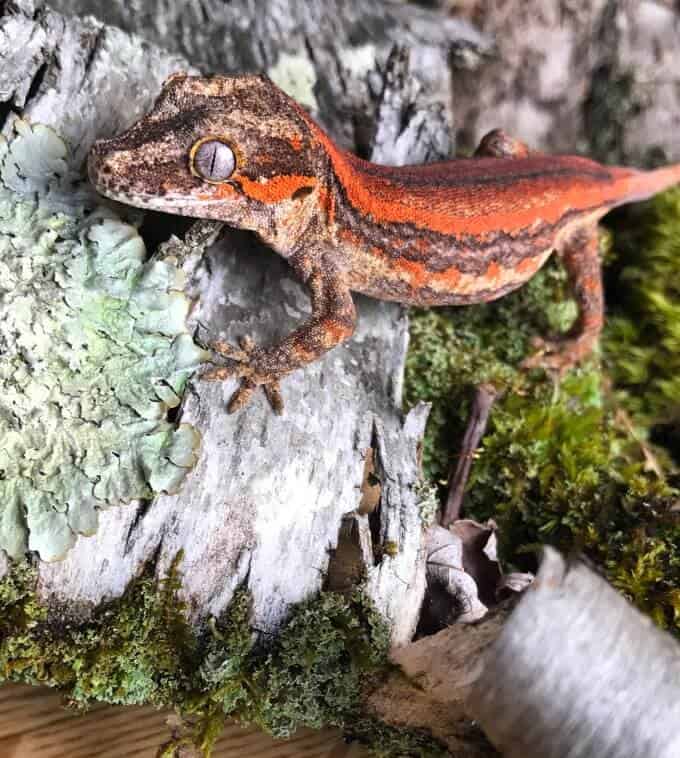
Next, add a collection of climbable branches and vines. Use some branches with virgin bark to absorb moisture. Arrange the climbing surfaces so that your gecko has multiple paths to different parts of the environment.
Artificial and live plants are also a must when it comes to their habitat setup. The plants will collect water on the leaves for the gecko to drink. Live plants can also help with humidity levels. Devil’s Ivy, Philodendron scanden, and Ficus benjamina are good choices.
At the bottom of the enclosure, provide a small hide box. Place some damp sphagnum moss to create a humid environment that the gecko can use in times of shedding.
Temperature & Lighting
Gargoyle geckos are a bit unique when it comes to their temperature and lighting needs.
These lizards don’t need an ultra-warm environment like some other pet reptiles do. Some owners don’t even provide supplemental lighting or heating! Gargoyle geckos are highly adaptable and do well in standard room conditions.
That said, you may want to use some equipment to ensure that the conditions are just right.
Temperatures should be no hotter than 85 degrees Fahrenheit. You can use that measurement as a guide to create a temperature gradient. Use a low-powered basking lamp or heating mat on one side of the enclosure to create a warm spot in the upper 70s or low 80s.
On the opposite end, temperatures should be around 74 degrees Fahrenheit. The temperature gradient isn’t going to be extreme, but it’s necessary nonetheless.
Expert Tip: You can also provide a low-level UVB light. A 5-percent UVB bulb should be more than enough to cover the entire enclosure.
Humidity
Moderately high humidity levels are essential for the health of this species. The gargoyle gecko prefers levels of 60 to 70 percent.
It’s important to invest in a digital hygrometer to monitor the humidity levels regularly. Adjust the vents on the enclosure to make sure you’re trapping enough moisture. Depending on your climate, you may have to mist the substrate and plants daily.
Water
You will likely never see your gargoyle gecko drinking from it, but we still recommend placing a small water dish in the enclosure. Use a shallow dish that’s large enough for your pet to climb inside, since they may soak occasionally to help with shedding.
Clean and replenish the water regularly. If your gecko defecates in it, clean the dish out as quickly as possible to prevent the buildup of bacteria (which can lead to serious health concerns).
Food & Diet
Gargoyle geckos are omnivores, but they can still be a bit picky. As an example, they sometimes avoid eating live insects.
You can try appropriately sized crickets, dubia roaches, mealworms, or waxworms. Use gut-loaded insects and dust them with calcium and multivitamin supplements every other feeding.
If your gecko is not accepting live foods, you can rely on commercial fruit and vegetable foods. Sold as powders, these foods turn into a balanced mash that most gargoyle geckos can’t resist!
Expert Tip: Adult geckos need to eat every two to three days. Juveniles may require daily feedings.
Potential Health Issues
There aren’t any unique diseases that plague this species. However, gargoyle geckos can suffer from most of the common ailments that impact pet reptiles.
The most common issues you may encounter include metabolic bone disease, respiratory infections, and bacterial problems.
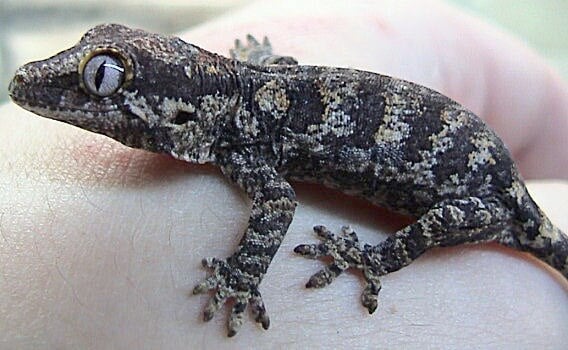
Metabolic bone disease is a result of not having enough calcium. Reptiles require UV exposure to synthesize calcium naturally. Without it, the bones can become brittle and injury-prone. To avoid this issue, provide a source of UV light and provide calcium supplements with their food.
Respiratory infections are usually caused by improper temperature and humidity levels. It can lead to inflammation in the soft tissue around the mouth and nostrils. Address this issue as soon as possible to avoid future complications!
Finally, there are bacterial infections. These infections can wreak havoc on your lizard’s body. Luckily, they’re easy to avoid with proper cleaning.
Expert Tip: It’s important to spot clean the enclosure daily and perform a deep clean every month. When you deep clean, disinfect every item in the habitat.
Behavior & Temperament
Gargoyle geckos are usually quite docile and easy-going. However, they can exhibit territorial behavior when kept with others. Interestingly enough, both males and females can get aggressive when they’re around others of the same sex.
Males tend to the bigger aggressors, so that’s a combo you should always avoid. You can keep a single bonded pair together. Some have seen success in keeping a single male with up to three females, but females can still fight with one another.
These geckos can release their tail in times of stress. The tail will eventually grow back over several months, but it’s best to avoid this altogether by keeping gargoyle geckos separate or in a bonded pair.
Gargoyle geckos are crepuscular. This means that they’re most active during dawn and dusk. You might see them climbing around on branches and leaves. But during the day, they will usually lounge and remain still.
Handling Advice
Gargoyles are a species that doesn’t mind human interaction. They do just fine when handled for short periods. However, you must exercise caution at all times.
Let your gargoyle gecko go from one hand to another until they get settled. Don’t try to constrain them in any way unless it’s absolutely necessary. Doing so can cause stress or injury.
When you try to constrain them, gargoyle geckos are prone to biting. Bites aren’t particularly painful, but it’s something you obviously want to avoid!
Let them get comfortable in your hand and never handle them if they’re not in the mood. If your pet seems stressed, give the lizard some space before attempting to hold it again.
Wrapping Up
Gargoyle gecko care is not very challenging, as long as you have the correct requirements. When a pet reptile becomes popular there’s a tendency for misinformation to get passed around, so you need to be cautious when it comes to following advice and recommendations.
We hope this care sheet helps make the process easier, and gives you the confidence to go out and purchase one of these fantastic pets! We’ve been a big fan of this species for a while and know plenty of other owners who have nothing but great things to say.
Have fun!

